|
We Have Finally and Officially Moved!
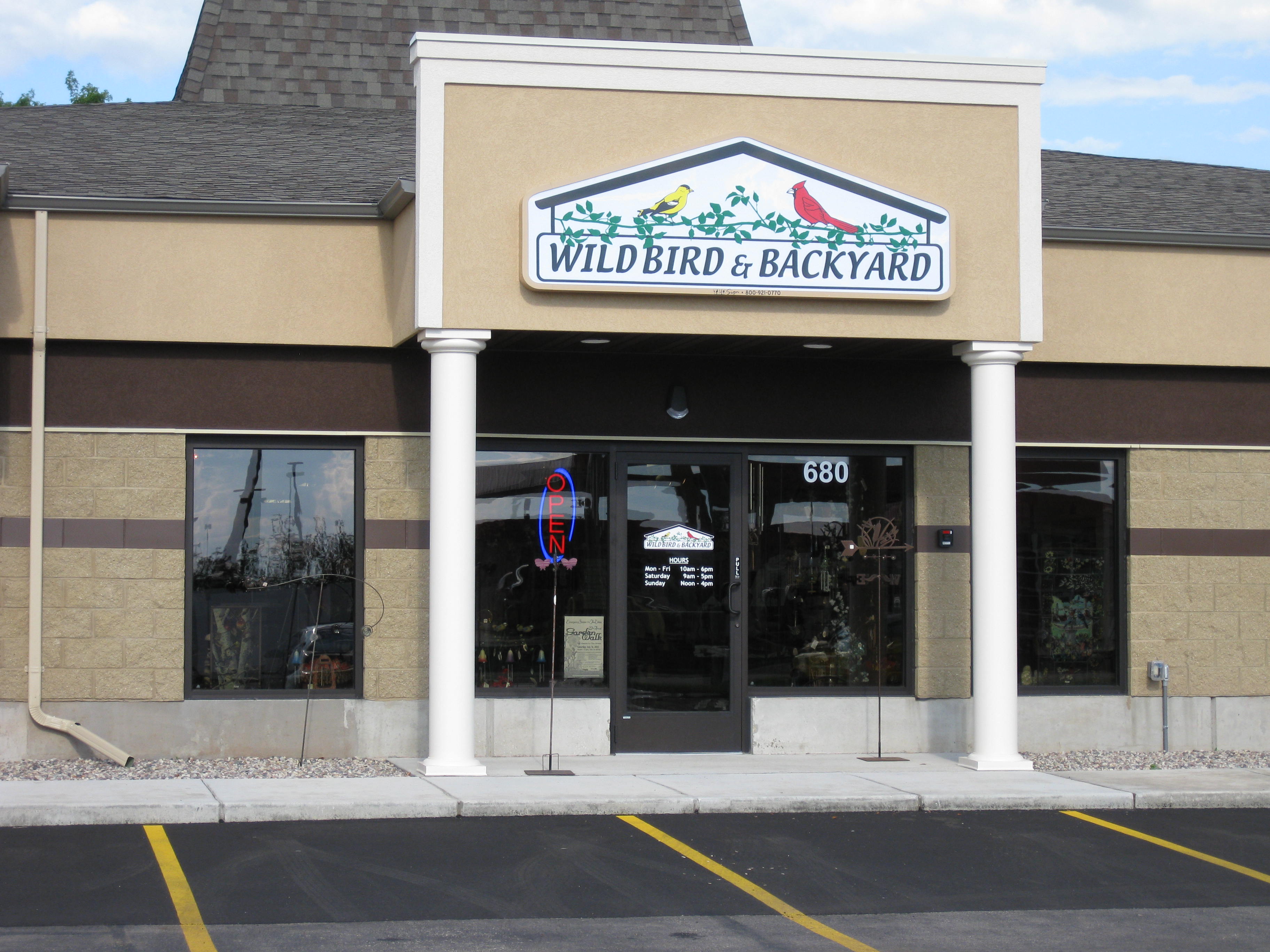 The long anticipated "MOVE" finally is over and we are comfortably settling into our new store. It's on Westhill Blvd., on the east side of the street, directly across from the entrance to Woodmans and Culvers. The new address is 680 North Westhill Blvd., the phone number and hours are the same as we had on College Avenue. We're excited to annouce this new location has an additional parking lot in the rear with direct store access from that parking area. We have our seed section in the rear of the store, so feel free to use our back door, especially if purchasing seed. It will be convenient for you and provides ease of getting the seed into your vehicle. The long anticipated "MOVE" finally is over and we are comfortably settling into our new store. It's on Westhill Blvd., on the east side of the street, directly across from the entrance to Woodmans and Culvers. The new address is 680 North Westhill Blvd., the phone number and hours are the same as we had on College Avenue. We're excited to annouce this new location has an additional parking lot in the rear with direct store access from that parking area. We have our seed section in the rear of the store, so feel free to use our back door, especially if purchasing seed. It will be convenient for you and provides ease of getting the seed into your vehicle.
Our new expanded showroom area will allow us to enlarge our product selection, so please visit often and see the amazing items we are continually adding. Step foot into our "patio" and see our fountain bird baths, along with our enlarged selection of varied bird baths. Pick up a shopping basket for your small bagged seed or suet - no more juggling these items in your arms. Can't find something or need some advice? We're here to assist you, just ask. Personal, friendly and educated assistance, that's what we'll continue to offer you. Next, we've begun planning for a Grand Re-Opening Celebration with guest speakers, manufacturer reps and owners, prizes and discounts. Stay tuned - we'll let you know more as the plans come together.
How To Attract a Greater Variety of Birds
We are often asked the questions as to what should be added to a feeding station to attract more variety of birds, or what should be offered besides seed. Each bird species has food preferences and these may change seasonally. For example, fats are essential for feather coloration and protein helps feathers grow stronger. Offering multiple kinds of foods throughout the year will help attract a greater variety of birds to your feeding station on a regular basis. At Wildbird & Backyard, we offer regionally-formulated seed blends without fillers or additives. While the black oil sunflower seed is the most commonly consumed seed, offering a variety of seeds, or a seed blend, would be like a human eating from a buffet table, being able to eat what is attractive or needed at the moment. We also recommend offering a broader selection of foods, beyond seeds, that will attract a greater variety of birds and will meet their nutritional needs.
Peanuts
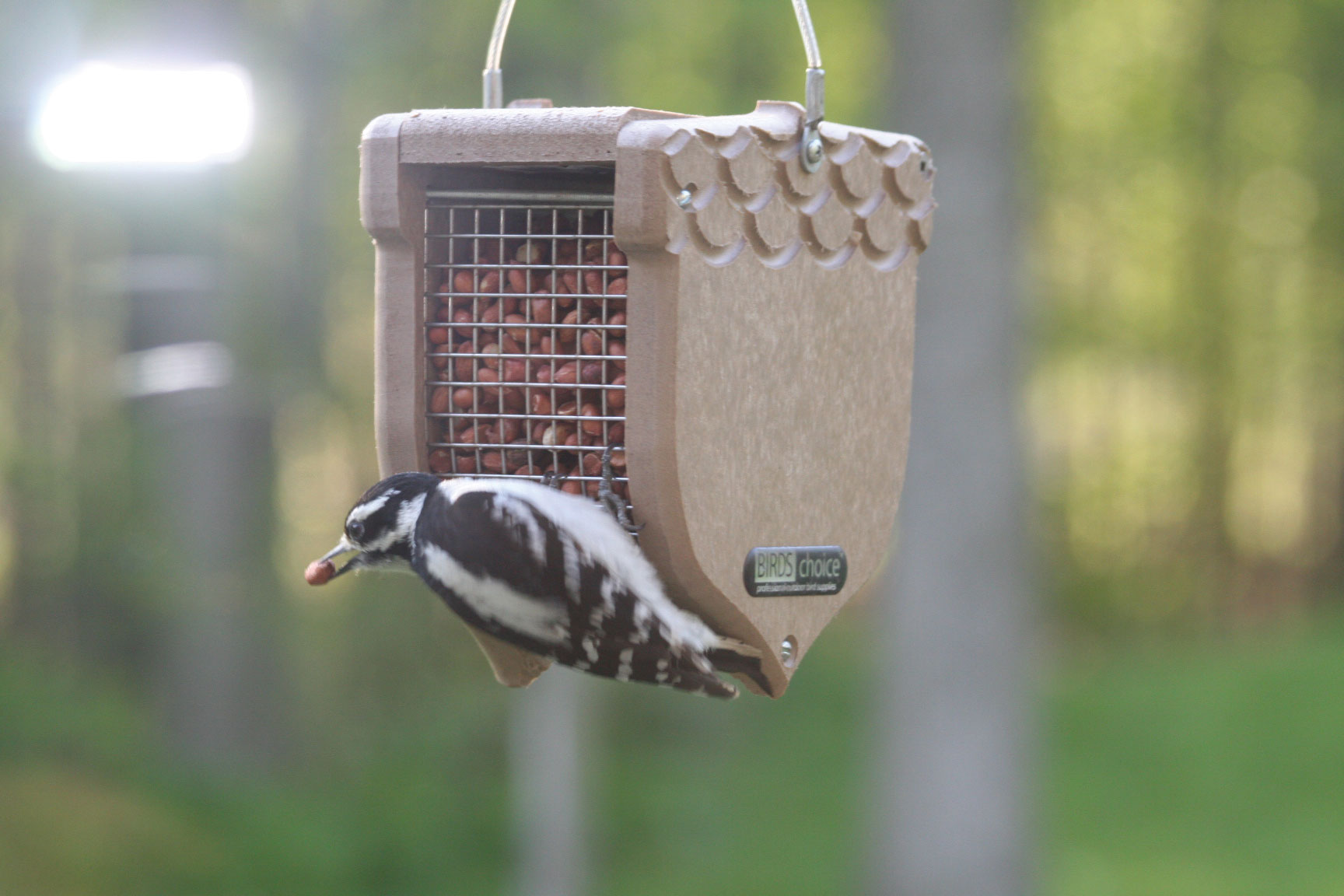 These are the best single source of protein and fat for the birds and are available either in the shell or out of the shell. Some birds will take and store the nuts for the future or they may eat them on the spot. Peanut pieces are offered in smaller quantities in all of our seed blends but they can also be offered alone. Special Peanut Feeders are available for both the shelled and non-shelled varieties. Offer them to the Blue Jay, Nuthatches, Tufted Titmouse and Woodpeckers and Cardinals. These are the best single source of protein and fat for the birds and are available either in the shell or out of the shell. Some birds will take and store the nuts for the future or they may eat them on the spot. Peanut pieces are offered in smaller quantities in all of our seed blends but they can also be offered alone. Special Peanut Feeders are available for both the shelled and non-shelled varieties. Offer them to the Blue Jay, Nuthatches, Tufted Titmouse and Woodpeckers and Cardinals.
Nyjer
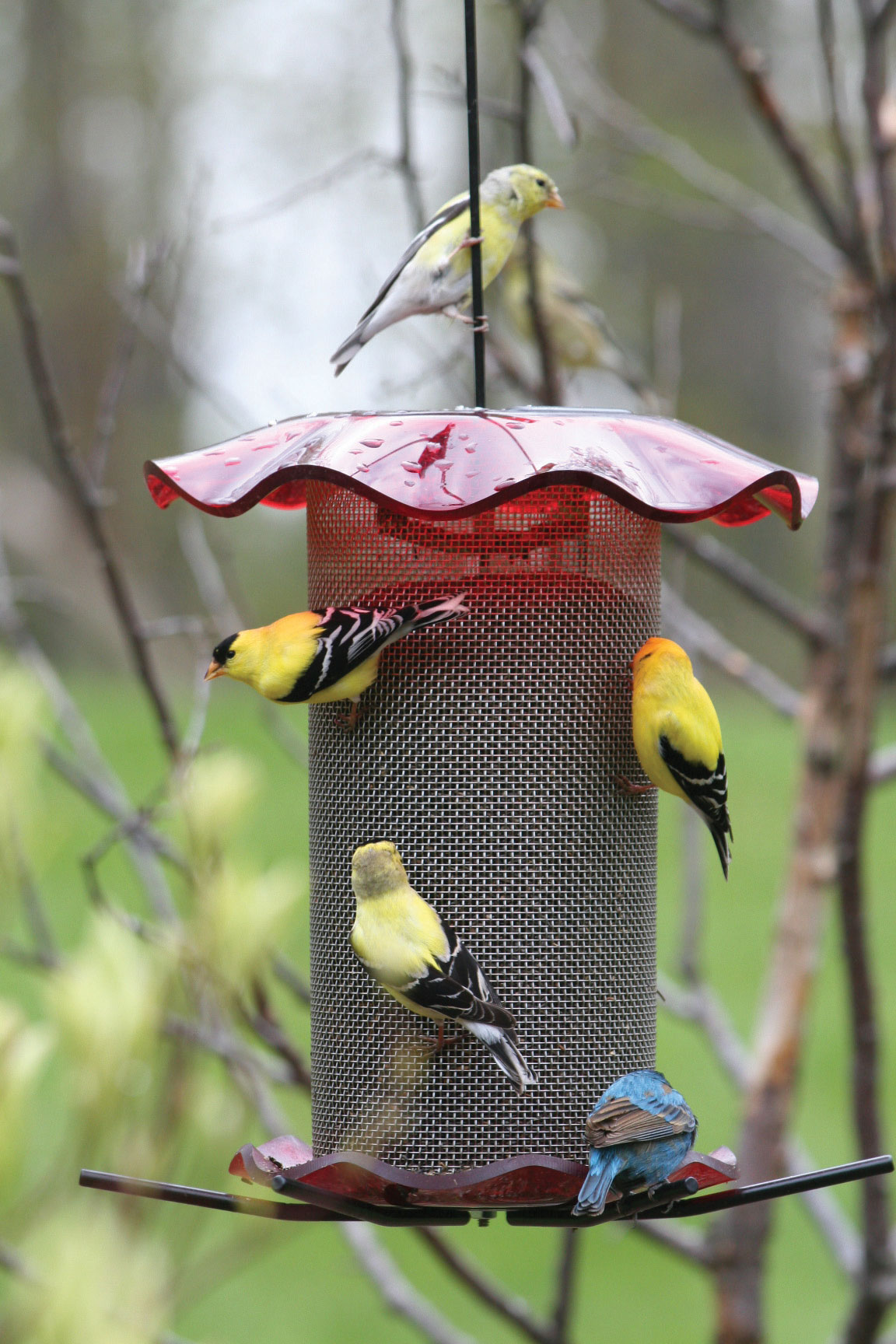
This is the favored seed of Goldfinches but also attracts the Indigo Bunting, Mourning Doves, Juncos and Pine Siskins. Nyjer has a high oil content and is an excellent source of energy for active birds. Nyjer can be offered alone or in a blend called “Wild Finch Mix”. Offering both the Nyjer alone and also in the Finch Mix will insure all your finches have everything they enjoy eating, everything that is good for them. In our yard even the chickadees eat from the Wild Finch Mix. These 2 choices are offered in specialized feeders because of the size of the seed. Finch feeders include mesh socks, tube feeders and variations of tube feeders.
Mealworms
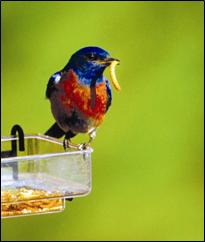
Not all birds are seed eaters, some are insect eaters. Bluebirds, Robins and Wrens are a few examples of insect eaters. Mealworms are the best offering for these birds. Mealworms are offered in smooth-sided feeders/bowls/dishes rather than the typical bird feeder. They can be purchased either in the dehydrated form or live. Wildbird & Backyard currently only offers the dehydrated variety.
Nectar
 Liquid food is consumed by Hummingbirds and Orioles. This liquid is basically a sugar/water blend that can be purchased in a mix or can be made right in your kitchen. We advise offering the hummingbird nectar without any red coloring as the red coloring agent is harmful to the hummers. We carry a large variety of both hummingbird and oriole nectar feeders. The drinking vessel is different between the feeders although it may not be that strange to see hummers drinking from oriole feeders and orioles feeding at hummingbird feeders. Most hummingbird feeders are decorated with red and oriole in orange, as those colors are attracted to the corresponding species. Liquid food is consumed by Hummingbirds and Orioles. This liquid is basically a sugar/water blend that can be purchased in a mix or can be made right in your kitchen. We advise offering the hummingbird nectar without any red coloring as the red coloring agent is harmful to the hummers. We carry a large variety of both hummingbird and oriole nectar feeders. The drinking vessel is different between the feeders although it may not be that strange to see hummers drinking from oriole feeders and orioles feeding at hummingbird feeders. Most hummingbird feeders are decorated with red and oriole in orange, as those colors are attracted to the corresponding species.
Fruit and Jelly
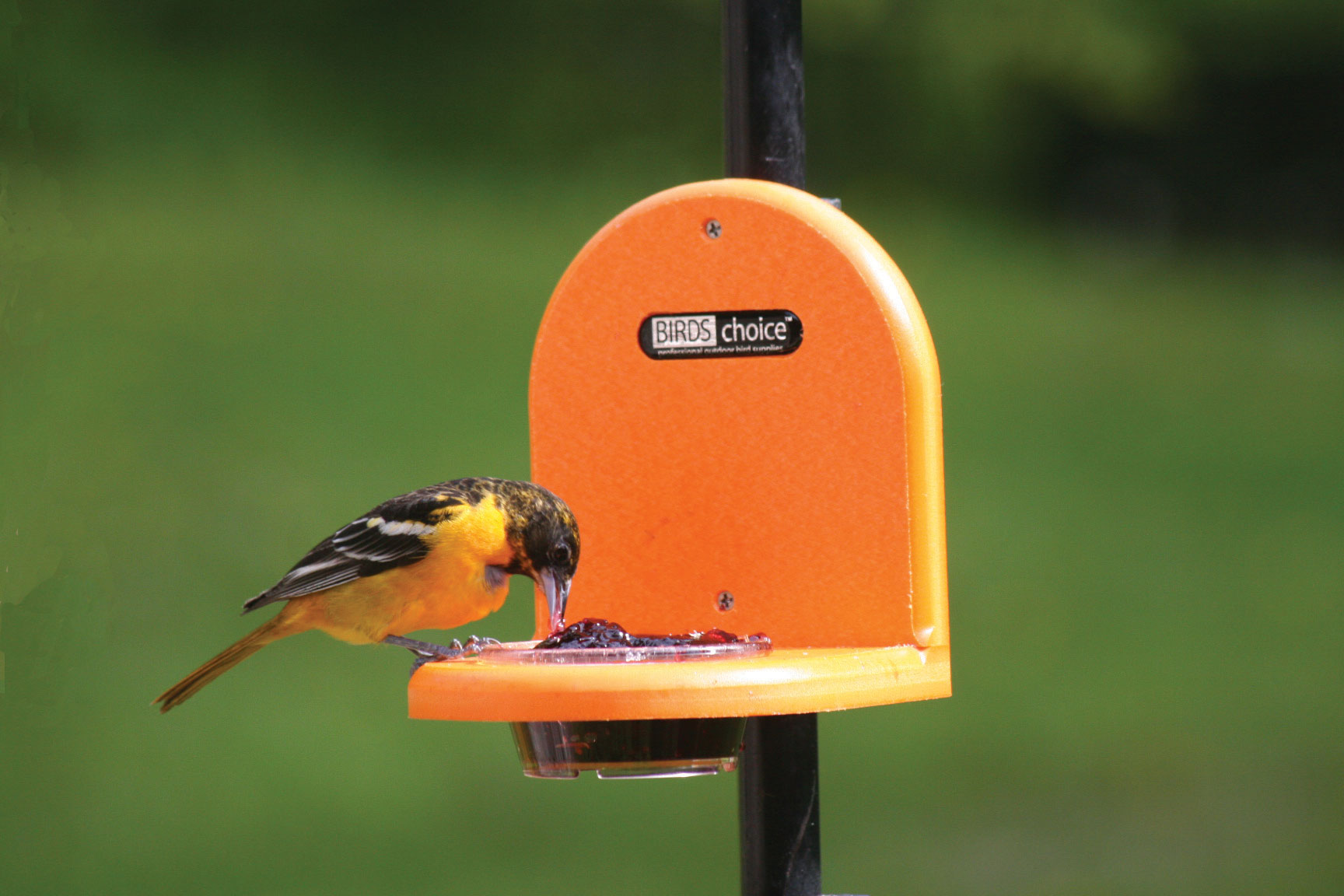 Ever heard of birds attacking a berry patch? Fruit is enjoyed by a variety of birds and can be offered in many seed feeders with larger trays (larger hoppers, fly-throughs and platform feeders). Wildbird & Backyard has a large variety of unique fruit feeders to supplement your seed feeders (which might also double up and be used as mealworm feeders). You can offer the birds grapes, apple pieces, oranges, raisins, craisins and berries. Fruit eaters include Bluebirds, Orioles, Finch, Gray Catbird and Chickadees. Ever heard of birds attacking a berry patch? Fruit is enjoyed by a variety of birds and can be offered in many seed feeders with larger trays (larger hoppers, fly-throughs and platform feeders). Wildbird & Backyard has a large variety of unique fruit feeders to supplement your seed feeders (which might also double up and be used as mealworm feeders). You can offer the birds grapes, apple pieces, oranges, raisins, craisins and berries. Fruit eaters include Bluebirds, Orioles, Finch, Gray Catbird and Chickadees.
Suet
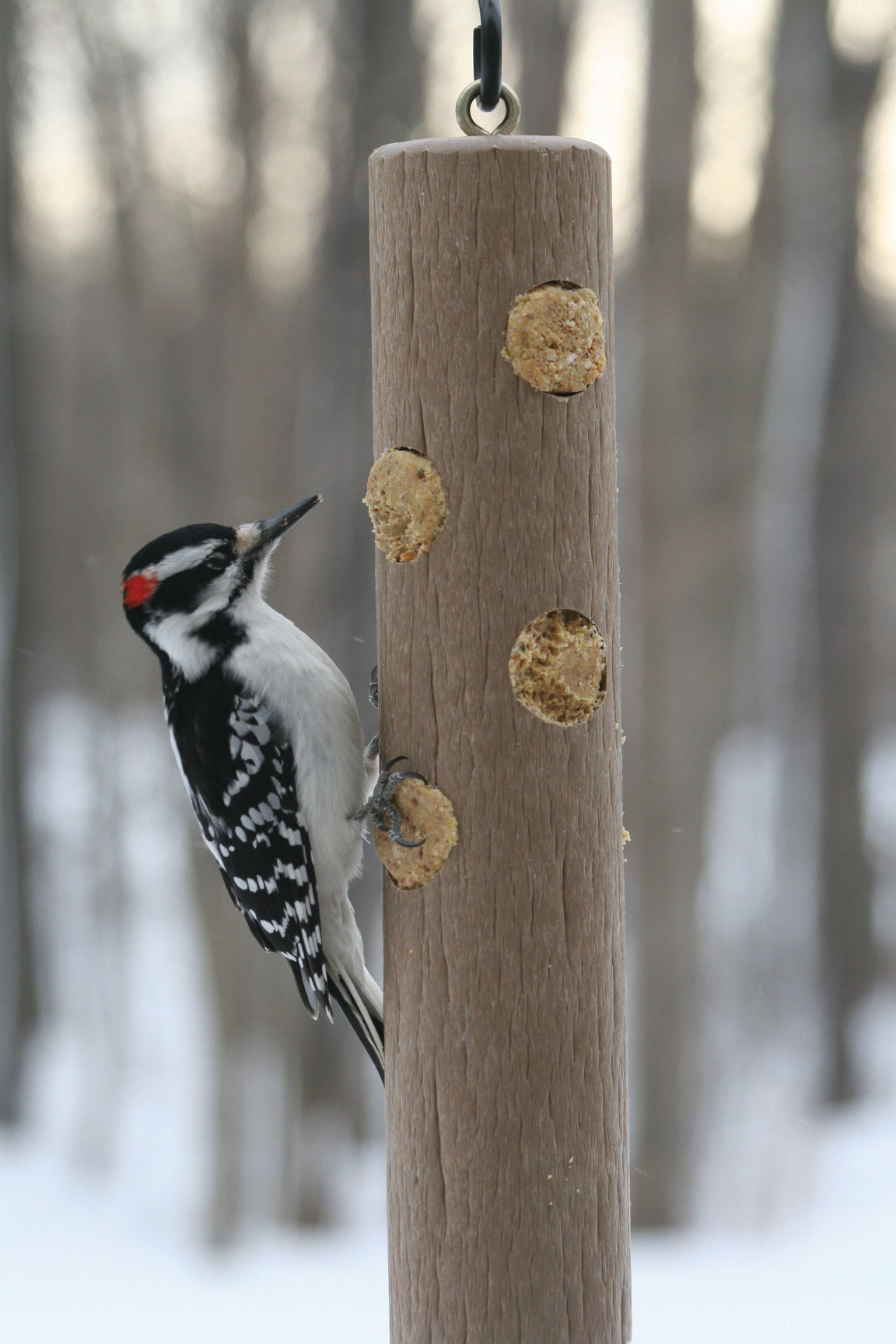 This is the Woodpecker’s favorite but also enjoyed by Chickadees, Nuthatches, Tufted Titmouse and Wrens. Suet is a high-energy, pure-fat substance that birds enjoy all year long, offered in various sizes and styles of cages and log feeders. It is particularly helpful in winter when birds need more calories to fend off the cold temperatures. Different varieties are available that are supplemented with peanut butter, insects, nuts, fruits and seeds. Our suets can be offered year-round without the fear of melting in warmer weather. This is the Woodpecker’s favorite but also enjoyed by Chickadees, Nuthatches, Tufted Titmouse and Wrens. Suet is a high-energy, pure-fat substance that birds enjoy all year long, offered in various sizes and styles of cages and log feeders. It is particularly helpful in winter when birds need more calories to fend off the cold temperatures. Different varieties are available that are supplemented with peanut butter, insects, nuts, fruits and seeds. Our suets can be offered year-round without the fear of melting in warmer weather.
.jpg)
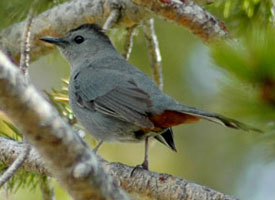 The Gray Catbird is a medium-sized, slender songbird with a long, rounded, black tail and a narrow, straight bill. They have fairly long legs and broad, rounded wings. They give the impression of being entirely slaty gray but a closer look will reveal a small black cap, blackish tail and a rich brown patch under the tail. Look for Gray Catbirds in dense tangles of shrubs, small trees and vines, along forest edges, streamside thickets, old fields and fencerows. They are secretive but energetic, hopping and fluttering from branch to branch through tangles of vegetation. Singing males sit atop shrubs and small trees. They are reluctant to fly across open areas, preferring quick, low flights over vegetation. Related to mockingbirds and thrashers, they share that group’s vocal abilities, copying the sounds of other species ad stringing them together to make their own song. The Gray Catbird’s long song may last up to 10 minutes. The male uses his loud song to proclaim his territory and his softer version when near the nest or when a bird intrudes his territory. The female may sing the quiet song back to him. They are a migrating bird, only in Wisconsin for the summer, for breeding. They winter along the Atlantic Coast, and the Gulf Coast from Florida through Texas and all the way down Central America and the Caribbean. In summer they eat mainly ants, beetles, grasshoppers, caterpillars and moths. When fruits are available they also eat holly berries, cherries, elderberries, poison ivy and blackberries. They are sometimes garden pests, eating or damaging raspberries, cherries, grapes and strawberries. The Gray Catbird is a medium-sized, slender songbird with a long, rounded, black tail and a narrow, straight bill. They have fairly long legs and broad, rounded wings. They give the impression of being entirely slaty gray but a closer look will reveal a small black cap, blackish tail and a rich brown patch under the tail. Look for Gray Catbirds in dense tangles of shrubs, small trees and vines, along forest edges, streamside thickets, old fields and fencerows. They are secretive but energetic, hopping and fluttering from branch to branch through tangles of vegetation. Singing males sit atop shrubs and small trees. They are reluctant to fly across open areas, preferring quick, low flights over vegetation. Related to mockingbirds and thrashers, they share that group’s vocal abilities, copying the sounds of other species ad stringing them together to make their own song. The Gray Catbird’s long song may last up to 10 minutes. The male uses his loud song to proclaim his territory and his softer version when near the nest or when a bird intrudes his territory. The female may sing the quiet song back to him. They are a migrating bird, only in Wisconsin for the summer, for breeding. They winter along the Atlantic Coast, and the Gulf Coast from Florida through Texas and all the way down Central America and the Caribbean. In summer they eat mainly ants, beetles, grasshoppers, caterpillars and moths. When fruits are available they also eat holly berries, cherries, elderberries, poison ivy and blackberries. They are sometimes garden pests, eating or damaging raspberries, cherries, grapes and strawberries.
Make Your Backyard a Bird Haven

Interest in songbirds grows every year. Bird feeding is perhaps the most popular wildlife-related activity in the country. Most of us enjoy seeing and hearing birds and birdwatching is a fascinating year-round hobby for many people. The bright flashes of color, the distinctive songs, the life birds add to the landscape and the opportunity you have to observe their interesting habits make spending time and effort to encourage their presence well worthwhile.
About 330 species of birds migrate through or stay in Wisconsin. Of these, 12 or 15 songbird species commonly nest in residential areas of cities and towns and 16 or 17 more build nests around rural home sites. Besides these nesting birds, some migrant birds may stop for a day or two during their migration if they find your yard attractive. Don’t forget about the birds that stay over the winter. They add life and color to an otherwise bleak and snowy scene. Invite them into your yard with winter attractive plants. If you give some thought to landscape planning and planting, you can greatly increase the chance that birds will nest in your yard. A delightful thing about birds is the seemingly capricious way they select home sites. You can never predict exactly where a bird will build its nest, so it’s a pleasure when they choose your backyard.
Landscape plantings make home grounds attractive to birds in several ways. Plants furnish year-round shelter and protection from predators. They provide safe nesting sites and rearing places. They also can supply food in the form of fruit, seeds and nectar. Birds also find plantings convenient and attractive places to hunt for insects.
Different birds require different habitats. A few birds demand open spaces without trees and little or no shrubby vegetation; others look for dense trees and some seek out flowers for nectar. In selecting trees, shrubs or vines, consider their general landscape value as well as the value for birds. You can meet both goals by selecting plants with good foliage, attractive flowers, fruits, interesting branches and twigs and a generally neat appearance. You may want to enclose our backyard for privacy. Wider-planted areas can furnish the dense thickets some bird’s desire. Use low-branching shrubs next to the lawn, giving good transition from the grass to the shrub border. These low-branching shrubs also help protect ground-nesting birds. Every landscape planting needs at least a few conifers (evergreens) if it is to have maximum value for songbirds. Spruce, arborvitae, junipers, yew, pines and firs provide excellent nesting cover and winter shelter. Conifers also make excellent windbreaks for birdfeeders during winter. Viburnums are excellent shrubs that offer translucent fruits enjoyed by grosbeaks and cedar waxwings.
Most nurseries and seed catalogs now recognize and promote the values of certain plants for birds and other wildlife. Staff people often can advise you on our best choices. In fact several nurseries in Wisconsin specialize in food and cover plants for wildlife. Plant your backyard so it’s pleasing to your eye while making it a perfect spot to attract songbirds for all the seasons. It could be a bird haven.
Bird Questions and Answers
Cornell Lab of Ornithology Answers Bird Questions
Q. If I handle a baby bird, won't its parents pick up my scent and abandon it?
A. It's a myth that parent birds will abandon young that have been touched by humans—most birds have a poor sense of smell, and birds in general identify their young using the same cues we humans do—appearance and sound. It's perfectly safe to pick up a fallen nestling and put it back in the nest, or to carry a fledgling out of danger and place it in a tree or shrub.
Q. Why do birds leave the nest before they can fly?
A. It's to some young birds' advantage to leave the nest as soon as they can. People tend to think of nests as safe, cozy little homes. But predators have a pretty easy time finding a nest full of loud baby birds, and nests can be hotbeds of parasites. So parent birds work from sunrise to sunset every day to get their young grown and out of the nest as quickly as possible. After fledging, the young birds are more spread out, and the parents can lead them to different spots every night, enhancing each one's chances of survival. Some species, such as swallows, woodpeckers, and other cavity nesters, nest where there are no nearby branches for young to awkwardly grab onto when they first leave the nest. Unless startled by a predator, young of these species tend to remain in the nest until they are strong fliers.
Q. We have a hawk that comes to our yard on a regular basis, and yesterday he killed a Mourning Dove. How can I get rid of him and keep the songbirds and doves?
A. Hawks that feed on birds apparently take the term bird feeder at face value. If you want to discourage the hawk, you'll have to take your feeders down for a few days, until the smaller birds disperse. In the wild, birds face constantly fluctuating food supplies, so songbirds, doves, and hawks alike will know to search for food elsewhere. Put your feeders up again in a week or two. If you're lucky, the songbirds and doves will quickly return but the hawk will have found hunting grounds somewhere else.
Featured Product: Granite Bird Baths
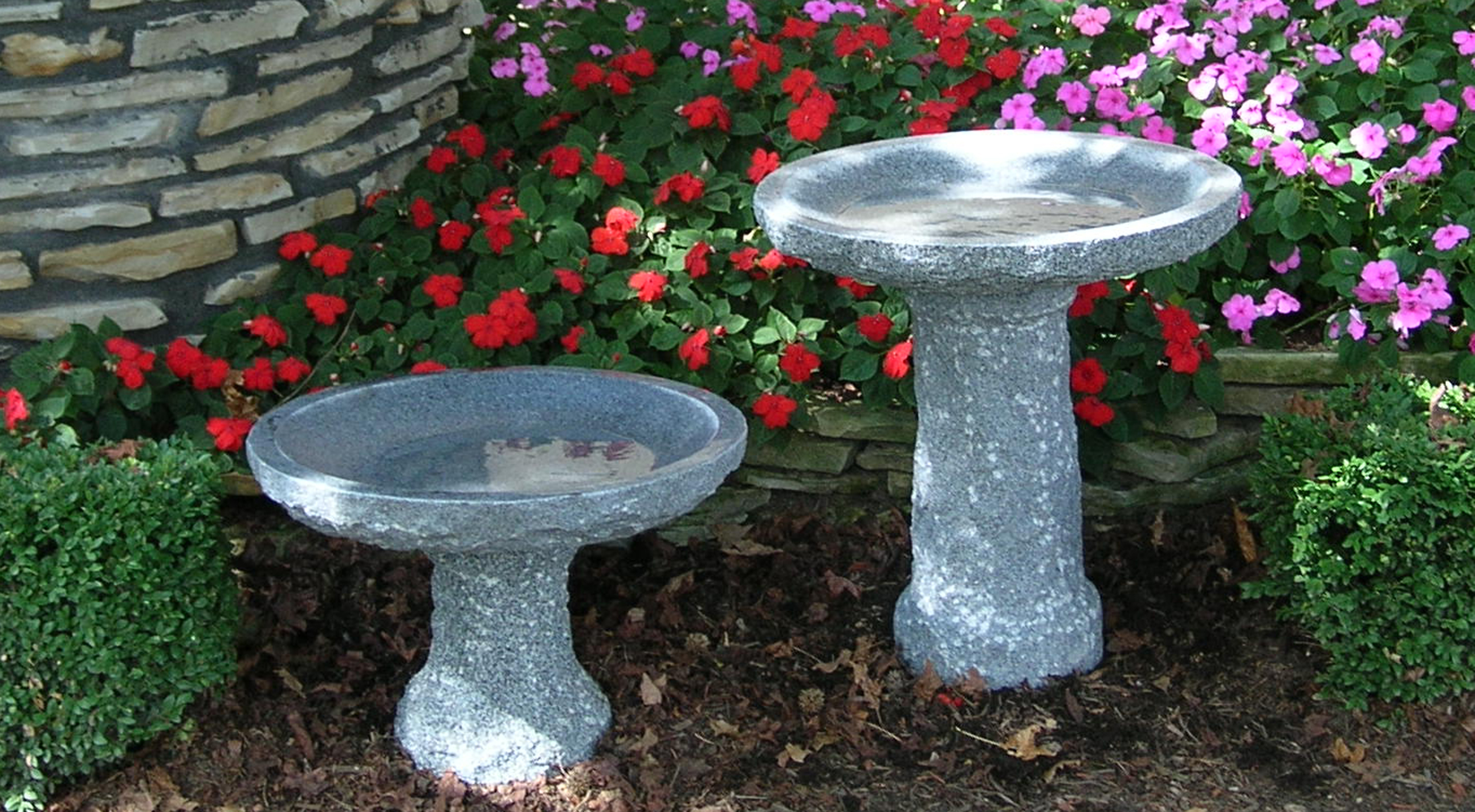
Here is another "Made in the USA" product, granite bird baths by Stone Age Creations. These baths are made in Ohio from real stone as created by Mother Nature. The stones, in different styles and colors, have endured harsh outdoor environments for thousands of years and will continue to do so long after you have purchased them. Baths constructed from concrete, plaster, clay or resin won't pass the test of time compared to these stone creations. Yes, they are heavy. Yes, each one is made individually so they are unique in size and exact weight. The basin is ground, the rims are polished and the edge is chiseled - one at a time, just for your backyard! They will truly be a piece of beauty in your backyard AND the birds will be ever so grateful for the water you offer to them. We have also stocked an array of owls made from the same granite - individually created and so adorable. A sweet addition to any yard! Take advantage of the coupon below and bring a piece of beauty into your backyard this summer - and save money too.
Mike's Message
How could MIKE’S MESSAGE begin any other way than writing about the store move? First, I publically thank my staff, Dave, Bob, Nancy (and family), friends and wife for their incredible effort in making this happen. Working endless hours for three days, we opened on time and in great shape. We had so many gracious offers of help from customers, thank you all. Thanks especially go out to Bill, Carol and Lisa for their outstanding help. Maureen and Andy (sister-in-law and nephew), Jeff and Jackson (godson and his son) and Terry (cousin) were incredible in packing, cleaning, putting the warehouse together, moving and lending trucks and equipment. Dan and Ruth Bloedorn, owners of Birds Choice birding products in Chilton, were incredible in their tireless help – and truck. Dan and Ruth, we owe you big time! Then my friend Ron, who wasn’t asked to help and never offered to help but just showed up…and showed up…and showed up – many thanks. Thanks to all of you from the bottom of Pat’s and my heart. It was a great undertaking and it happened – because of all of you.
So here we are in our new store. The feedback has been gratifying; we tried to maintain similar color schemes and layout to make the store feel “similar and friendly”. Because of a little more space, new items have already started arriving. Come see our granite birdbaths and adorable granite owls. They just make you smile! More new items will be coming over the next many weeks.
We are seeing many new faces in this Westhill location and although the smell of fresh bread is driving my crazy each morning, the Breadsmith is a fantastic neighbor. “Seed and Feed” in one stop shopping. This new store has one exciting feature – a back door! If the front parking lot is busy, please drive around to the back of the building as we have a fairly exclusive parking lot back there. Our seed, by design, is in the back of the store so for your convenience you can drive to the back and be out in a snap!
Demand for seed has been great – both because of the new customers and the fact that the birds have been so hungry. Please bear with me while I adjust to these new demands and learn how to better regulate my weekly seed orders. I thank you in advance for your patience and understanding if I occasionally run short of something while I’m in this learning curve.
We will have an official Grand Re-Opening in the months ahead. Stay tuned for more.
Happy Birding, Happy Summer, Mike
Special Customer Coupons!
|